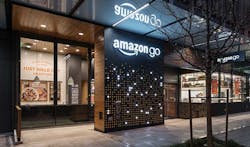Data and devices are everywhere. And Amazon Web Services wants to extend its cloud to wherever that data resides.
At its annual re:Invent conference last week, AWS said it plans to extend its edge computing capabilities by adding 30 new Local Zones around the world, along with new ways to connect to the “Internet of Billions of Things.” Amazon Web Services rolled out new chips and servers, along with a sharper focus on industry-focused cloud services.
In a keynote address and blog post, Chief Technology Officer Werner Vogels outlined Amazon’s vision for “the everywhere cloud,” bringing AWS to new locales through targeted hardware and solutions.
“We’ve already seen the cloud go practically everywhere,” Vogels wrote. “The shift we’ll witness in 2022 is the cloud becoming highly specialized at the edges of the network. To fully realize the benefits of the cloud in workshops and warehouses, in restaurants and retail stores, or out in remote locations, there must be tailored solutions at the edge.”
The AWS cloud operates in 25 geographic regions and 81 Availability Zones across the globe, with more than 310 points of presence to serve over 245 countries and territories, Vogels said.
“But now, we are seeing cloud services that are pushing beyond the bounds of our traditional AWS Regions and out to the edges of the network,” he said.
Bringing the Cloud to the Nasdaq
AWS Outposts and Local Zones are the key building blocks for Amazon’s edge computing strategy, and at reInvent the company illustrated how it came use these tools to create powerful business solutions that connect to the heart of the global financial system.
AWS Outposts are racks filled with turn-key AWS cloud infrastructure, which allow enterprises to deploy hybrid clouds in their on-premises data centers. Outposts will also drive Amazon’s push into edge computing through Local Zones, which are regional facilities filled with Outposts. AWS currently has Local Zones available in 13 North American markets, often housed in colocation facilities. Local Zones provide low-latency access to cloud services for services like video and graphics rendering.
At reInvent, AWS announced that NASDAQ will move its exchanges onto the AWS Cloud in a deal that illustrates how AWS can use its edge infrastructure products to target specific vertical markets.
“Using the capabilities of AWS Outposts, we can now bring the edge directly into our primary data center in Carteret, New Jersey, creating the first ever capital markets Private Local Zone,” said Adena Friedman, President and CEO of Nasdaq. “Together, we will create a cloud center inside the Nasdaq footprint, which allows us to transition our U.S. markets into the cloud.”
The solution addresses a challenge for security-conscious financial services firms, who have reservations about shifting workloads into cloud data centers. So instead, the AWS cloud is extending into Nasdaq’s core network to deliver ultra-low-latency edge compute capabilities. Beginning in 2022, Nasdaq plans to migrate its North American markets to AWS in a phased approach, starting with Nasdaq MRX, a U.S. options market.
“Our innovative new collaboration with AWS creates a bridge to the future for our markets and represents the next major step forward in Nasdaq’s cloud journey,” said Friedman.
Beyond the Data Center With Outpost Servers
AWS also introduced smaller form factors for its Outposts, making it easier to deploy the full stack of AWS services outside of traditional data centers, in locations like branch offices, retail stores, factories, health clinics and cell towers. The 1U and 2U servers will be available in the first quarter of 2022, and can be shipped to the user location and either mounted on a 19-inch rack or even positioned on a flat surface, AWS says.
“What we will see in 2022, and even more so in the years to come, is the cloud accelerating beyond the traditional centralized infrastructure model and into unexpected environments where specialized technology is needed,” said Vogels. “The cloud will be in your car, your tea kettle, and your TV. The cloud will be in everything from trucks driving down the road, to the ships and planes that transport goods.”
IoT expert Stacey Higginbotham said Vogels “outlined a future of computing that’s utterly distributed and tailor-made for the internet of things, yet still leaves Amazon in control.”
“It’s clear the computing giant recognizes that computing happens outside of its own servers,” Higginbotham wrote in her Stacey on IoT newsletter. “Moreover, its executives have recognized that it needs to build services designed to help its customers bridge their local compute-ingesting sensor data back to the cloud, and do so in a manner that’s both easy and secure.”
The Re:Invent News Firehouse
Each year the re:Invent conference features a flood of new announcements. Here are some links to notable new services:
- Meta Networks (Facebook) announced a strategic partnership with AWS “to complement its existing on-premises infrastructure.” AWS and Meta will help machine learning researchers and developers by further optimizing PyTorch, a library for Python programs that helps developers build deep learning projects. Interestingly, Meta said it will “use the cloud to support acquisitions of companies that are already powered by AWS.”
- Amazon continues to advance the development is its custom chips, offering early details about the next generation of its ARM-based Graviton cloud server chips.
- On the sustainability front, AWS announced 18 new renewable energy projects in the U.S. and Europe, representing 2 gigawatts of clean energy capacity.
- On the networking front, AWS introduced Private 5G as a Service and a Cloud WAN offering.
- AWS continues to offer options for legacy infrastructure to become cloud-enabled, including a Mainframe Modernization service introduced at re:Invent.
About the Author



